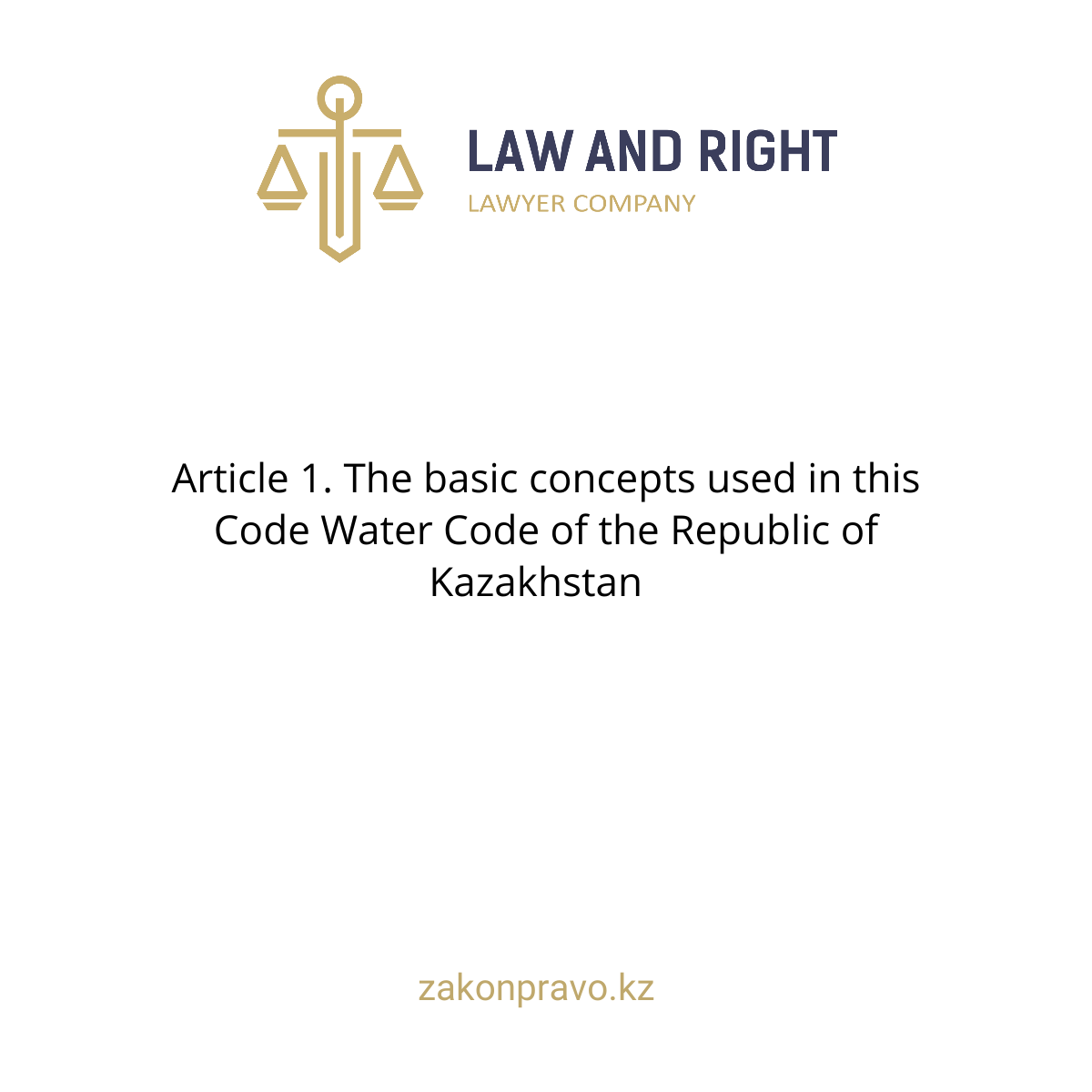Article 1. The basic concepts used in this Code Water Code of the Republic of Kazakhstan
The following basic concepts are used in this Code:
1) water area – a body of water limited by natural, artificial or conventional boundaries;
2) drinking water – water in its natural state or after treatment, meeting the quality of established national standards and hygienic standards, intended to meet drinking and household needs;
3) non-alternative sources of drinking water supply are the only sources of drinking water supply for water consumers, the replacement of which is impossible and impractical;
4) alternative water sources – accumulated rainwater and meltwater, treated wastewater and desalinated salt water, which can be used as water resources;
5) the boundary of division of balance ownership is the line of division of elements of water supply and sanitation systems between owners on the basis of ownership, economic management or operational management;
6) hydraulic engineering structures – structures for regulating the use of water resources (including intake, storage, transportation, distribution of waters from surface water bodies and drainage of drainage waters), as well as other structures designed to protect against the harmful effects of waters (water-retaining, spillway and outlet structures, structures designed to protect against floods and destruction of the shores);
7) drainage – collection and discharge of water from the earth's surface and (or) lowering of the groundwater level;
8) drainage water – water collected and discharged by collector-drainage networks;
9) groundwater – water resources of underground water bodies;
10) a deposit and a section of groundwater is a spatially limited part of an aquifer system in which favorable conditions exist for the extraction of groundwater of a certain quality in an amount sufficient for their intended use;
11) land hydro–reclamation is a set of measures that improve natural conditions for the use of irrigated lands by regulating the water regime of soils;
12) regulation of surface runoff – distribution (redistribution) of river runoff using retaining hydraulic structures, depending on the water content of the year, to meet the water needs of various water users, taking into account the protection of water bodies and the prevention of harmful effects of water;
13) sanitation of surface water bodies – restoration of the hydrological regime of a surface water body by cleaning from bottom and silt deposits, dredging, channeling, shore protection and other works;
14) irrigation – water supply for irrigation of agricultural lands;
15) multifactorial inspection – assessment of the technical condition of hydraulic structures and main equipment, determination of the residual life of their elements by visual inspection and conducting a complex of engineering studies (geodetic, geophysical, geotechnical, hydrographic and others);
16) a tubular filter well is a structure in the form of a pipe drilled into the ground with a number of holes located in the first aquifer from the surface;
17) channels equated to rivers are artificial structures designed to transfer water from one basin to another, from one river system to another, interstate channels;
18) the boundary of the division of operational responsibility is the dividing line of elements of water supply and sanitation systems based on responsibilities (responsibility for their operation), established by agreement of the parties. In the absence of such an agreement, the boundary of operational responsibility is established along the boundary of the division of the balance ownership;
19) wastewater – water formed as a result of human economic activity or in a polluted territory: water used for industrial or household needs and thus received additional impurities of pollutants that changed their original composition or physical properties; rainwater, melt water, infiltration water, irrigation water, drainage water flowing from the territories of settlements and industrial enterprises; groundwater collected along the way during subsurface use operations (quarry, mine, mine waters, reservoir waters collected along with hydrocarbons);
20) wastewater storage facilities – facilities designed for the accumulation of wastewater (storage ponds, filtration fields and evaporation ponds), which are part of complexes of centralized wastewater disposal systems;
21) monitoring and assessment of the reclamation status of irrigated lands – a system of observations and analysis of hydrogeological, hydrological and soil indicators to identify negative changes and take measures to prevent them, as well as develop recommendations for improving the reclamation status of irrigated lands;
22) allocation point – the place of transfer of water resources from a water user to a water consumer;
23) wastewater disposal – a set of measures that ensure the collection, transportation, treatment and discharge of wastewater through wastewater disposal systems into water bodies, wastewater storage facilities or terrain;
24) objects negatively affecting the state of waters – buildings, facilities, structures and devices, the operation of which may lead to pollution and (or) clogging, and (or) depletion, and (or) harmful effects of waters;
25) technological expenses of water – volumes of water spent on maintenance of constructions and networks of systems of water supply and sanitation of settlements;
26) organizational and accounting discharge of water - the volume of water that is not recorded by water metering devices due to their insufficient sensitivity, measurement errors, as well as when indicators of water metering devices are not taken at the same time by water consumers;
27) water protection zone – an area adjacent to water bodies, where a special regime of economic activity is established to prevent pollution, clogging and depletion of waters;
28) a water protection strip is a part of a water protection zone adjacent to water bodies, in which a regime of limited economic activity is established in addition to a special regime of economic activity in water protection zones;
29) the authorized body in the field of protection and use of the water fund (hereinafter referred to as the authorized body) is the central executive body responsible for the management and intersectoral coordination in the field of protection and use of the water fund;
30) water supply – a set of measures that ensure the collection, storage, preparation, supply and distribution of water resources;
31) water supply – a set of measures aimed at meeting the needs of the population, the environment and economic sectors in water resources;
32) protection of water bodies – a system of measures aimed at the conservation and restoration of water bodies;
33) use of water bodies – the use of water bodies as a component of the natural environment;
34) a water body is a permanent or temporary concentration of waters in natural or artificial landforms or in the subsurface, having boundaries, a natural or regulated water regime, with the exception of wastewater accumulators;
35) water user – an individual or legal entity who, in accordance with the procedure established by the legislation of the Republic of Kazakhstan, has the right to use water and exercises it;
36) water regime – a natural or artificial change over time in the levels, flows and volumes of surface and groundwater;
37) water resources – water contained in surface and underground water bodies, including those available for use, taking into account protection from pollution, clogging and depletion;
38) water intake facility – a complex of structures and devices for water intake from water bodies;
39) the specific rate of water consumption and sanitation is the set amount of wastewater consumed or discharged per unit of output (for a certain amount of work performed or services rendered);
40) consolidated rate of water consumption and sanitation – the specific rate of water consumption and sanitation for a branch of the economy;
41) water consumer – an individual or legal entity using the services of water management organizations for the supply of water or water users, or consuming water from water bodies in the order of general water use;
42) water conservation – a system of measures ensuring economical and efficient use of water resources;
43) water management is a branch of the economy related to the protection of the water fund and the use of water resources;
44) water management facilities – facilities and devices designed for the intake, purification, storage, distribution of water and drainage of drainage waters;
45) water management organizations – legal entities whose activities are related to the regulation, delivery of water resources, water supply, sanitation, development and operation of water management and hydraulic structures;
46) engineering flood and meltwater protection systems – dams (avalanche systems), mobile fences, redistributing and bypass channels, temporary reservoirs, estuary irrigation systems, embankments and other structures that allow intercepting, redistributing and temporarily retaining excess water;
47) transboundary water bodies – surface or underground water bodies crossing borders between two or more states or located on such borders;
48) authorized body in the field of housing relations and housing and communal services - the central executive body responsible for management and intersectoral coordination in the field of water supply and (or) sanitation;
49) a mine well is a vertical mining operation, the depth of which is greater than the cross–section, created for the intake of groundwater in the aquifer first from the surface for the purpose of water supply, drainage of rocks and drainage of atmospheric and surface waters from the earth's surface;
50) a capillary structure is an engineering and technical structure that ensures the opening and use of groundwater at its natural outlet to the earth's surface.
The Code of the Republic of Kazakhstan dated April 9, 2025 № 178-VIII LRK
President
Republic of Kazakhstan
© 2012. RSE na PHB "Institute of Legislation and Legal Information of the Republic of Kazakhstan" of the Ministry of Justice of the Republic of Kazakhstan
Constitution Law Code Standard Decree Order Decision Resolution Lawyer Almaty Lawyer Legal service Legal advice Civil Criminal Administrative cases Disputes Defense Arbitration Law Company Kazakhstan Law Firm Court Cases


